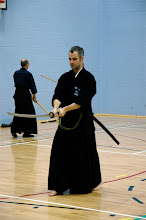The thing which hit me strongest in this period is Sensei's use of the word "toho".
刀 = to; sword
法 = ho; law
刀法 = sword method
This is also often translated into swordsmanship or sword methodology. The way Ishido Sensei uses it though is more along the lines of efficient and effective use of the sword. He has often used this term before to describe the objective of certain kata e.g. sogiri which have very little logical application as a scenario but instead are for developing one's toho or sword skills.
What seems more obvious now though, as explained by Ishido Sensei, is the importance to develop one's toho; that knowing and running through the shape of the kata is not enough; one has to gradually develop the fundamental cutting parts. This is not described or explained in any particular detail in the seitei manual so I assume that this is something that is taught by teachers on an individual basis (kuden or oral transmission).
I have written articles for the BKA news before which presented a dichotomy of a kata being either a situational one (jokyo) or a sword method one (toho). I also mentioned that most people of a senior grade actually looked at all the kata as toho development routes. If one considers this a bit more deeply, even in more ancient times, the chance that the exact same combative situation would arise as the one that a person had trained in must have been fairly low. It makes more sense that one is training the component parts of the kata rather than the situation the kata presents.
Some of the toho points that were mentioned this week (at least one from Aurelien) include:
- Ensuring that the sword was turned completely to the side before sayabanare in ichimonji forms such as Seitei Mae to prevent the sword making a "double nukitsuke" i.e. the sword moves in a direction inconsistent to the cut when leaving the saya.
- That the kissaki should move in an upwards motion when commencing kirioroshi instead of being pulled forwards.
- That the second oblique cut in Sogiri requires the right hand to be slightly loosened and rotated to ensure that sword is completely on the centre at the end of the cut.
- Hikinuki leading to ukenagashi ni kaburi can be achieved by softening the arms as the body turns.
- That the small fingers should be properly on the tsuka while drawing the sword up in Nukiuchi with a kirite (cutting grip) so that at the moment of sayabanare the sword should move up and elevate to a near horizontal position immediately.
In the end one can see that toho is something of a science to be studied, learned, trained and mastered if one's iai is to be full rather than just being a collection of various forms. Having this well embedded would surely allow the warrior of times before be able to turn their hand to whatever situation arose, hence achieving tsune ni itte, kyu ni awasu (being in a state of calm, quickly adapting to the situation).




Oh, I'm pleased you're writing these again! Its been too long.
ReplyDelete